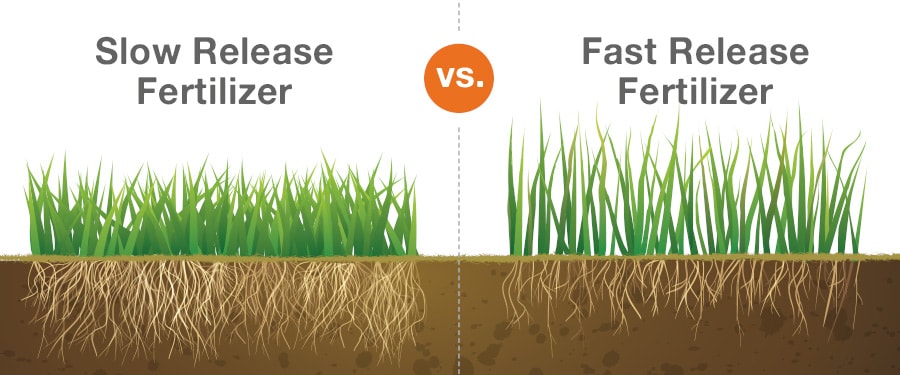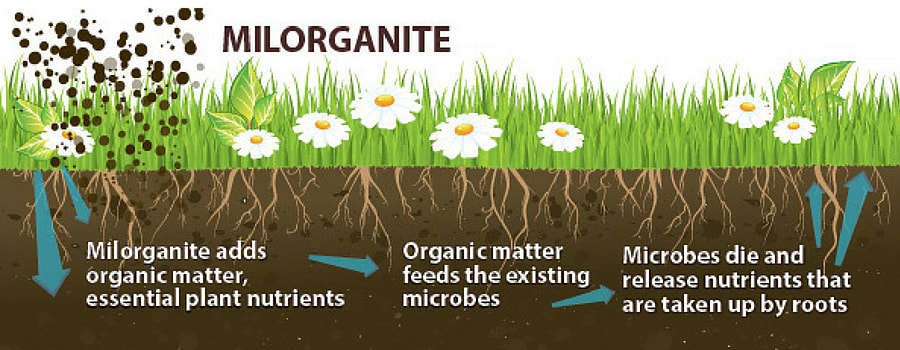Slow-Release vs. Quick-Release Fertilizer
- Milorganite AgronomistMay 12, 2018
Fertilizer: Which is better?
Fertilizer is applied to lawns, landscapes and gardens to supplement nutrients lacking in the soil and making them available when plants need them: right now or over an extended period.
The goal for lawns is to produce a reasonable amount of top growth. The key word here is “reasonable.” Rapid bursts of top growth resulting from immediately available nitrogen can actually weaken lawns, as grass plants are producing top growth at the expense of root development, making them more susceptible to disease. Healthy root systems are key to a healthy lawn.
The nutrients in slow vs quick-release fertilizers may be the same, but how they’re derived and delivered differ. A mix of slow- and quick-release nitrogen may be what your lawn needs for a quick boost for greening and long-term, sustainable growth.
Why Use a Slow-Release Fertilizer?
Slow-release fertilizers are derived from natural materials. They can also be coated, synthetic fertilizers, typically in a pellet form. Both release nutrients at a slower rate, based on moisture and temperature.

Pros
- Good for well-established lawns.
- Encourage more uniform growth.
- Less likely to burn lawns and other plants. Milorganite, for example, is a non-burning, slow-release nitrogen fertilizer.
- They can last 6 to 8 weeks or longer. Plants receive the nutrients they need over a longer period of time.
- There is no growth burst like you get with quick-release fertilizers, so you won’t have to mow as often.
- Extended release of nutrients puts less stress on grass plants. It doesn’t force fast growth that’s not natural.
- Stronger turf reduces the chance of lawn diseases.
- Safer for the environment. Slow-release fertilizers are significantly less likely to leach.
- They don’t need to be watered in, although it will more quickly start the process of releasing nutrients.
- Green up lasts longer.
Cons
- Nutrients are not immediately available to plants.
- Cool soil may inhibit effectiveness. Microbes need the right amount of moisture and warmth, with soil temperatures at least 50 F, to be active, and break down nutrients to make them available to plants.
- Organic-based fertilizers require more water during periods of high temperatures, which may release nutrients more rapidly. Under these circumstances, you might consider allowing your lawn to go dormant to save water and reduce the risk of nutrients leaching into the groundwater or local waterways.
- Maybe more expensive than quick-release fertilizers.
- Green-up may take longer.
Why Use a Quick-Release Fertilizer?
Quick-release fertilizers are derived from manufactured, synthetic nutrients.
Pros
- Nutrients are immediately available to grass plants.
- Useful when plants need an immediate boost of nutrients, such as newly established lawns or, in some situations, to help a lawn quickly grow out of a disease. Also when a quick, aesthetic boost is needed for an outdoor event.
- Soluble nitrogen is easily dissolved in water after it’s applied.
- Stimulate quick grass-shoot growth and greening.
Cons
- Rapid release into the soil may lead to nutrient leaching, which is harmful to the environment.
- Lasts only two to four weeks.
- Over application can burn lawns.
- Requires more frequent fertilizer applications and mowing.
There isn’t a single fertilizer that’s right for every lawn and situation. The best place to start, before choosing a fertilizer, is to have your soil tested to determine the nutrients that are lacking. If a soil test isn’t feasible, your next best option is to use a slow-release nitrogen fertilizer, such as Milorganite, four-time annually, to replenish nutrients in the soil to feed your lawn. Needlessly applying too much fertilizer, particularly quick-release, can harm your lawn, the environment and simply be a waste of money.
Carefully read product labels so you know what you’re buying and how it works to fertilize your lawn. As always, apply only the amount of fertilizer needed to maintain a healthy lawn and follow your local fertilization and watering restrictions.


